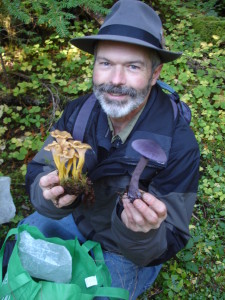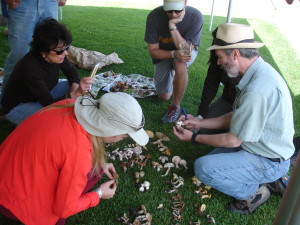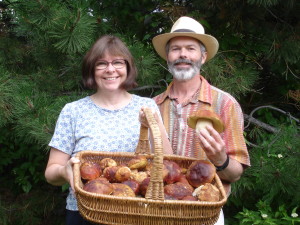A wet spring is not only welcome for our gardens, it also causes the mountains to spring forth mushrooms in abundance. It’s a mycologist’s dream.
Dr. Ken Kassenbrock, who teaches Mycology (BZ333) for the Department of Biology, is especially happy with our wet spring as he plans to once again teach mushroom hunting classes at the Eagle Mushroom & Wild Food Festival August 21 to 23.
http://eagleoutside.com/events/eagle-mushroom-wild-food-festival/
The mushrooms should be at their peak at that elevation.
Wild food has always been of interest to Dr. Kassenbrock. As he explored his interest in wild foods, discoveries about edible plants led to discovering edible fungi and mushrooms. He explains, “They seem otherworldly and transient. When you discover a big patch of mushrooms, it’s exciting!”
You could think of mushroom hunting as an Easter egg hunt for grownups. The big difference is that Easter eggs are pretty much, well, Easter eggs. Mushrooms come in many varieties and they look different at different stages of development. Because they can be toxic, it is critical to spend time learning identification, preferably with an experienced person to look over your shoulder.
Remember, it takes a long time to learn how to identify edible mushrooms. Not only do they look different in the wild from the pictures in the books, other factors such as smell and where it is found are important parts of identification. Kassenbrock suggests focusing on one species to begin. Learn what attributes are important and learn what you can confuse it with. Then you can branch out to other species to add to your body of knowledge.
Once you start, it’s easy to get hooked; you start looking forward to the rain. The season is short and it peaks in August in the high country. Hunting for the table is not for the faint of heart as it can be risky. Not only do you have to be certain of your identification, you also have to be right! And look out, long time mushroom hunters tend to protect their secret spots as mushrooms will fruit in the same area each year.
What’s interesting is that mushrooms require a healthy forest to grow; the relationship between fungi and trees is important. Identifying trees can be critical to finding mushrooms. Some species, such as chanterelles, porcini and truffles, absorb nutrients from trees and supply nutrients to their host in return. If the forest is out of balance, the mushrooms can’t thrive.
Finding them is one thing, eating is another. Different species of wild mushrooms have different flavors; some have a savory meaty character, others may be nutty, some even have notes of apricot or anise. Best with lighter foods to showcase the flavors, they are low calorie and very satisfying. It’s important to cook them. Some species, such as morels, are toxic when raw and require cooking to be edible. Cooking also gets the most nutrition out of them.
If you love the taste of mushrooms but prefer to pass on the stalking and foraging, you could grow them in your basement as Dr. Kassenbrock does. The best way to start is to purchase a kit online. Kits are fairly easy, requiring only watering and moist air, and a variety of species are available. Going beyond kits can be a bit more challenging as it requires pasteurizing or sterilizing things like straw, hardwood sawdust, or compost that different mushroom species use as food.
Growing your own allows you to have the species you want when you want them. If you love to garden, this will allow you to enjoy your hobby all year long, even in the middle of winter.



